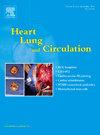Early and Midterm Outcomes of INSPIRIS RESILIA Versus AVALUS: A Propensity Score Matching Analysis
IF 2.2
4区 医学
Q2 CARDIAC & CARDIOVASCULAR SYSTEMS
引用次数: 0
Abstract
Objectives
To compare the early and midterm clinical outcomes of aortic valve replacement (AVR) using the INSPIRIS RESILIA bioprosthesis (IR-B) with AVR using the AVALUS bioprosthesis (AV-B).
Methods
This single-centre retrospective study analysed the perioperative clinical outcomes of 256 consecutive patients who underwent AVR with either IR-B (n=156) or AV-B (n=100) at this institution between 1 August 2018 and 30 June 2023. After propensity score matching, freedom from death, freedom from major adverse cardiovascular events (MACE), and echocardiographic data were compared between the two groups during the follow-up period.
Results
Propensity score matching resulted in the addition of 79 patients to each group. The 1-year survival rates in the propensity score-matched cohort were 93.8% and 94.5% in the IR-B and AV-B groups, respectively, while the 3-year survival rates remained unchanged, with no statistically significant differences between groups (p=0.88). At 3 years postoperatively, freedom from MACE was 93.2% and 92.8% in the IR-B and the AV-B groups, respectively, which was not statistically significant (p=0.90). The mean aortic pressure gradient after AVR remained stable in both the IR-B and AV-B groups (IR-B group, 10.7–11.3 mmHg vs AV-B group, 11.5–12.1 mmHg), and there was no significant difference observed between the two groups during the follow-up period. The absolute change from the baseline left ventricular mass index in both the IR-B and AV-B groups decreased in each group over time (IR-B group, −20.8 to −38.6 g/m2 vs AV-B group, −16.6 to −35.5 g/m2). However, these changes were statistically insignificant between the two groups over the 3-year follow-up.
Conclusion
The early and midterm clinical outcomes were comparable between the IR-B and AV-B groups.
与阿瓦卢斯相比,抗压性脑出血的早期和中期结果:倾向评分匹配分析。
目的:比较使用INSPIRIS RESILIA生物假体(IR-B)和使用AVALUS生物假体(AV-B)的主动脉瓣置换术(AVR)的早期和中期临床结果。方法:本单中心回顾性研究分析了该机构2018年8月1日至2023年6月30日期间256例连续接受IR-B (n=156)或AV-B (n=100) AVR患者的围手术期临床结果。倾向评分匹配后,比较两组随访期间的死亡自由、主要心血管不良事件自由(MACE)和超声心动图数据。结果:倾向评分匹配后,每组新增79例患者。倾向评分匹配队列中IR-B组和AV-B组1年生存率分别为93.8%和94.5%,3年生存率不变,组间差异无统计学意义(p=0.88)。术后3年,IR-B组和AV-B组的MACE自由度分别为93.2%和92.8%,差异无统计学意义(p=0.90)。IR-B组和AV-B组AVR后平均主动脉压梯度保持稳定(IR-B组10.7-11.3 mmHg vs AV-B组11.5-12.1 mmHg),随访期间两组间无显著差异。随着时间的推移,IR-B组和AV-B组左室质量指数相对基线的绝对变化均有所下降(IR-B组为-20.8至-38.6 g/m2, AV-B组为-16.6至-35.5 g/m2)。然而,在3年的随访中,两组之间的这些变化在统计学上不显著。结论:IR-B组和AV-B组的早期和中期临床结果具有可比性。
本文章由计算机程序翻译,如有差异,请以英文原文为准。
求助全文
约1分钟内获得全文
求助全文
来源期刊

Heart, Lung and Circulation
CARDIAC & CARDIOVASCULAR SYSTEMS-
CiteScore
4.50
自引率
3.80%
发文量
912
审稿时长
11.9 weeks
期刊介绍:
Heart, Lung and Circulation publishes articles integrating clinical and research activities in the fields of basic cardiovascular science, clinical cardiology and cardiac surgery, with a focus on emerging issues in cardiovascular disease. The journal promotes multidisciplinary dialogue between cardiologists, cardiothoracic surgeons, cardio-pulmonary physicians and cardiovascular scientists.
 求助内容:
求助内容: 应助结果提醒方式:
应助结果提醒方式:


